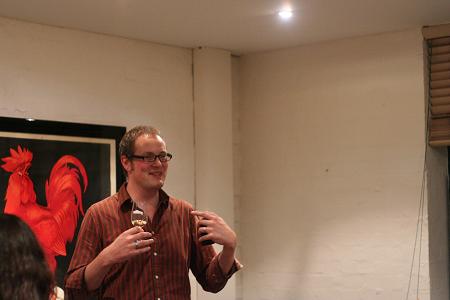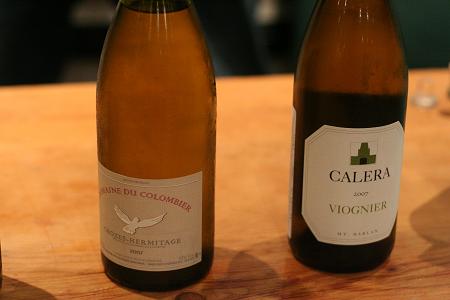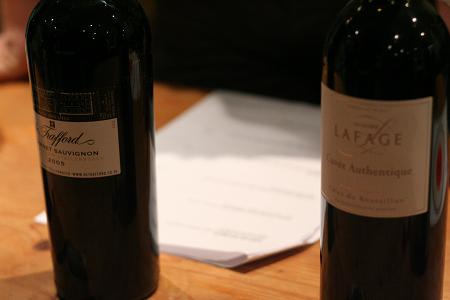Posted By Stephen
We have been to a few of the tastings organised by Dan from Bibendum and they have all been really good. At most of them, I have attempted to make notes and then given up at some point. This time though, I was determined to persevere and mostly succeeded. The previous tastings have been around a particular country theme, e.g. there was Italy and then there was Australia. This one was about grape varieties, and comparisons between different wines made from the same or similar grape varieties from around the world. This is the sort of tasting that makes you really think about the wine itself, rather than regional wines simply being a vehicle for someone to ramble on romantically about some particular corner of the world.

I wrote most of this post up about a week ago and have since been thinking about how to edit it down a bit, being as it was just a big list of tasting notes with a little commentary in between. I failed in that. Mostly because seeing as I had taken the trouble to write the notes in the first place and then to type them up, I couldn’t bear to delete any of it. So apologies if it’s all a bit long-winded.
There were quite a few people there and we chatted for a while before the very entertaining Willie started introducing the wines that were laid out for tasting on three different tables. A gesture from Dan quarter of the way through let him know that he was going a tad slowly, so he sped up his explanations for the rest of them. After that, people slowly morphed into groups and wandered towards tables. Kerri and I both found ourselves at the white wine table first, which suited us fine as it meant we could go through the wines in the generally accepted tasting order. Each table was split into two halves, each of which would be a variety or type of wine and each half would contain three wines. Dan had put these together from what he could easily source from Bibendum’s impressively wide wine range.
The white table was split into chardonnay and Rhône varietals. The first wine was an Italian chardonnay and pinot grigio blend rather than a straight chardonnay. This was Alois Lageder Biodynamic Chardonnay Pinot Grigio 2008 from Dolimiti, Italy. I have put down “pale gold” for the colour of most of these wines; not sure if that is genuine or if the lighting made me put that or if I was just a bit blinkered. Medium intensity wine with a biscuity aroma reminiscent of some Alsace pinot gris wines (clearly the pinot grigio side of this wine does not fall into the normal neutral / boring Italian version), with white flowers and light peach and a medium length finish.
Next up was St Romain Clos sous la Chateau Domaine des Forges 2006 from Burgundy in France. This had significant vanilla, toast and oak flavours to it; more so than most white Burgundies. Probably something to do with it coming from the same town in which one of the world’s largest oak barrel producers is based. Also peach, citrus and mineral notes. A potential favourite amongst the whites for me.
The last of the chardonnay section was Howard Park Chardonnay 2007, Great Southern, Western Australia. Australian chardonnay has had something of a bad rep for being over-oaked, over-sweet, flabby and not very interesting. But this one was different. Coming from Western Australia, which is one of the cooler wine regions in Australia, the grapes have a lot more character than those that go into the notorious Australian Chardonnays of the mass producers. Winemakers from Western Australia often point out that they only make 5% of the wine in Australia, but win most of the awards. This wine had ripe fruit, with peach standing out, which was balanced by good acidity and a light toasty note with some mineral characteristics too. A lovely wine, showing off Australia’s quality white wine potential very well.
The second half of the white table was entitled “Rhone White Varietals”, which was a collection of varietal wines (i.e. made from only one grape variety) from across the world that were based on varieties that were originally grown in either the northern or southern Rhone regions in France.
The first was from McLaren Vale in South Australia. We talked about Western Australia being a quality wine region rather than a bulk region and McLaren Vale is similar, and particularly known for Shiraz. This wine was 100% Roussanne, which is grown in the Rhone but can be a difficult grape to grow, being low cropping and prone to disease. Because of this, Rhone producers usually grow just a small amount of it and usually blend it with the more reliable Marsanne. In these blends, Marsanne gives the body and Roussanne provides an aromatic fruitiness. This being 100% Roussanne was aromatic and fruity indeed, very ripe from being grown in sunny McLaren Vale and tasted of cooked or tinned apricots with orange blossom and honeysuckle notes. It had a medium to full body and a slightly oily texture.

Next up was our new friend Marsanne, which was produced in its spiritual home, the Rhone itself, specifically in Crozes-Hermitage which is the younger sibling of the well known Hermitage. It had a low acidity and also had some honeysuckle notes, along with a light spice reminiscent of aniseed. It had a very oily texture which gave it a full body.
The last on the list was a Viognier which is grown around the world now but used to be mostly confined to Condrieu in the northern Rhone. In fact it almost died out as a commercial grape variety and there were very few acres of them left due to difficulty in growing it. However, over time people recognised its potential… as well as the money they could get for a bottle of it… and started planting it more widely. This particular example is from California and I found it well balanced, which I wasn’t expecting – both California and Viognier are known for high alcohol content which particularly in combination could lead to a rather unbalanced wine. Apricots again, this time dried rather than tinned, and more honeysuckle notes along with spice. Fullish in body again. A favourite of the table with some people in our group.
All the groups did manage to finish their first table visits at roughly the same time, so we moved onto the next. We were presented with three roses and three pinot noirs. In fact there were four pinot noirs because the last of the roses was made from it too. First up was a pale pink rose made from 50% grenache, 35% syrah (shiraz to some people) and 15% mourvedre and produced in Lirac in the southern Rhone. It didn’t seem to have greath depth of flavour and not many people felt it would be one of their favourites. It did have light strawberry and redcurrant notes with a creamy texture and some light space on the finish.
The next rose was a slight step up in flavour concentration and was made entirely from grenache, in this case in the guise of “garnacha” from just across the border in Calatayud, Spain. It was a medium pink colour, with strawberry, floral and orange notes and an interestingly nutty savoury finish.
The last of the three roses was a pinot noir from Adelaide Hills in South Australia, again a higher quality region of Australia which gives well balanced wines. This was off-dry rather than completely dry and tasted of red cherries and strawberry, with light leather aroma and noticable acidity. My favourite of the roses.
The first of the reds was the top contender for my favourite of the evening. It was a red Burgundy from Volnay, which is made as all quality red Burgundy is, from 100% pinot noir. It was a medium garnet colour, with cherry and meaty flavours, along with some light vegetal or forest floor notes and a cinnamon and clove spice. There were noticable tannins but they were not astringent and gave the wine a firm backbone to hold the other flavours together.

From there we moved onto a Chilean pinot noir, which was a ruby colour and also had a nose of cherry and spice, but the fruit had a jammy quality rather than being refined as in the Burgundy. It also tasted quite strongly of vanilla and had a tarry note, giving the impression it had had a little too much cheap oak contact.
The next pinot noir was from New Zealand, and in particular from Marlborough, which is better known for its sauvignon blanc. This one was ruby with a purple tint, with a cherry flavour and floral lavender notes. It seemed that it should have promise bit came across as a bit one-dimensional to me, it probably needs a couple of years to develop.
On to the final table, which was all reds and was split into Cabernet Sauvignon and Shiraz / Syrah, two of the best known red grapes from around the world. The first cabernet that we tasted was a 2004 from Mendoza in Argentina, produced by Catena who recently won the Decanter magazine’s Winemaker of the Year award. It was a garnet colour, showing its 5 years of age, with intense blackcurrant, dark plum, cedar and toast flavours. Medium acidity and a medium to full body. From the description that I wrote down, it sounds like it should have been good, but I didn’t give it that good a score, so it must not have impressed at the time.
Next up was a wine from the spiritual home of cabernet sauvignon – Bordeaux. This wine was from 2005 and hailed from Pauillac, a sub-region of Bordeaux which is well known for being the home of some of the biggest names in Bordeaux. Bordeaux wines are usually a blend of cabernet sauvignon with merlot and cabernet franc, with a couple of other grapes added in small amounts. Again, it had a medium garnet colour, with quite a deep core and on the nose there were notes of cedar, cigar box, plums and licorice. It was medium bodied, with medium to high ripe tannins and medium-high acidity too. Would be brilliant with roast beef.

The last of the cabernet trio was my second favourite of the evening, De Trafford 100% cabernet from Stellenbosch in South Africa, again from 2005. A deep garnet with a pronounced nose and flavour of blackcurrants, blackberries, cedar, violets, earth and eucalyptus. It had a full body with a lot of ripe tannin and medium acidity.
On to the first of the shiraz selection, which was 100% shiraz from California, 2008. It was a medium ruby colour with garnet tint and notes of flint, spice, licorice and smoke going well with the black cherry fruit and violet floral aroma. Quite a complex wine for one of this price from California.
The next was a blend from Cotes du Roussillon in the south of France. It contained 40% syrah along with 40% grenache and 20% carignan. It had slightly confected cherry fruit with white pepper spice. Notes were getting a bit sparse at this point!
The last was from Hunter Valley in Australia, from 2005. It was a bland of 92% shiraz with 8% tannat. It had lots of black cherry fruit, with a little plum fruit too, ripe bit not jammy.
After all the tasting, people filled up with a little of their favourites and continued to chat for a while until it was time to go. I tried to get another taste of the Volnay but it had disappeared by the time I got there, so I settled for some of the De Trafford cabernet instead.
A really interesting and informative evening, so many thanks to Dan for organising it and to the other Bibendum staff who presented the wines. We paid a (not so) quick visit to the pub afterwards of course and it was really interesting chatting to them all about the wines and of course wine and life in general.

4 Comments to 'Bibendum “Grape Expectations” Wine Tasting'
Subscribe to comments with RSS or TrackBack to 'Bibendum “Grape Expectations” Wine Tasting'.
:: Trackbacks/Pingbacks ::
No Trackbacks/Pingbacks
Leave a Reply
You must be logged in to post a comment.

You took far better notes than me! Thank you!
.-= LexEat´s last blog ..Lamingtons & a new appliance =-.
Great job on the notes Stephen – the differences between the regions and the styles are brilliantly explained. Sounds like the set-up this time worked much better for tasters – so we’ll do it like that next time too.
.-= Dan Coward´s last blog ..Jack of all Trades =-.
Erm my notes were generally composed of nonsensical single words like “hmm” and “ooof” with exclamation marks.
I did gain a lot from the evening though, very educational. I still don’t have a clue what eucalyptus smells of but then I didn’t grow up with it in my back garden. Unlike some of us, eh Stephen! ; )
Great write up.
.-= Danny´s last blog ..Two Soups =-.
I almost feel like I was there – I had to laugh at your opening – the one tasting I attended started so well but once I had a few wines they all just started to taste equally fabulous and I found it very hard to differentiate! Mind you I could certainly taste the difference when I had a budget glass of wine (labelled as being from that small wine region of “South Eastern Australia” ie a region around the size of Europe) at the pub afterwards.
.-= gourmet chick´s last blog ..The Square =-.